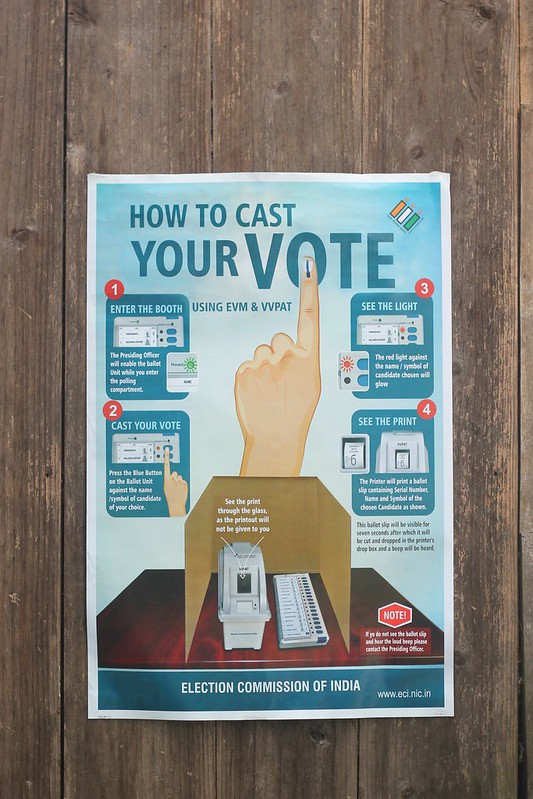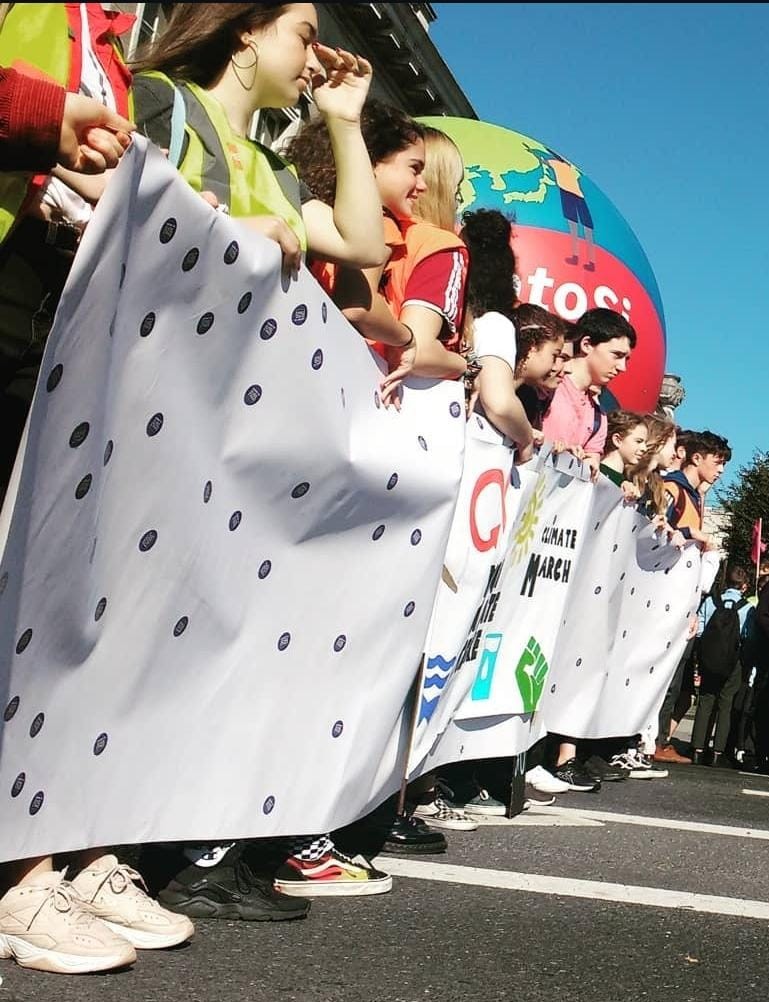Political Party Stoles on display. Photo by Al Jazeera English via Flickr (CC BY-SA 2.0)
This teaching unit has been developed to support teachers and students in learning about the 2024 elections in India, the power of the youth vote, and democracy.
The teaching unit is recommended for teachers of the following post-primary subjects:
CSPE (JC): Exploring democracy, Learning outcome 3.5, 3.6
The 2024 general election marked a critical turning point in the voting history of India. Through strategic planning, the Election Commission of India reported a remarkable increase in the number of youth voters in the country.
Compared to previous years, political parties made consistent efforts in 2024 to mobilise youth votes. As a result, the 2024 electoral roll recorded 210 million young voters between the ages of 18 and 29, making up a significant portion of the 970 million registered voters. Amidst this remarkable turnaround, an important question arises:
Why do youth votes matter in modern India?
Although the answer to this question can be complicated, the impact of youth votes can be understood by examining the role of young voters in shaping India’s democratic landscape, their level of political awareness, and their expectations from potential leaders.
The Critical Role of Young Voters
While the numbers presented by the 2024 electoral roll show a promising count of young Indian voters, Ashwani Kumar, Dean of the School of Development Studies at the Tata Institute of Social Sciences, criticised the ratio of registered young voters in comparison to the youth population in the country. He claimed that “In a country with a demographic pattern like India’s, logically the political space should be dominated by the youth and their concerns. But it is not.” Despite the claims of motivating young voters, the youth are greatly under-represented in Parliament. “In particular, millions of young people from the poorer eastern states of India are politically disenfranchised because they are migrant workers living in places different from where they are registered to vote.”
In the world’s largest democracy, the participation of youth cannot be defined using a numerical representation. The youth should be considered as a critical component of the democratic ecosystem that represents the country’s diverse and dynamic nature. Their absence from the voting process can create a gap between citizens and their democratic responsibilities. Educating the younger generation is therefore important to create a bridge between traditional values and future aspirations.

Cultivating Political Awareness among the Youth
Recognising the need for educating the youth about their democratic rights and political duties, the Government of India in 2022 launched a draft National Youth Policy aligning with its 2030 agenda for Sustainable Development Goals. The policy offers a structured plan for training young leaders to enhance their participation in politics and governance by proposing initiatives such as:
- Mock parliament programmes in educational institutions
- Civic engagement workshops
- Leadership training for young political enthusiasts
While these efforts aim to boost civic engagement and enhance youth familiarity with the procedures and functioning of the Indian Parliament, there is a lack of robust data to assess their effectiveness. Moreover, historical trends present a completely different picture as the densely populated states of Delhi, Bihar, and Uttar Pradesh recorded less than 40% of registered voters between 18 and 19 years old in the 2024 elections. On the other hand, Telangana saw a remarkable success in engaging 66.7% of registered voters from the youngest demographic. Similarly, Jammu and Kashmir and Himachal Pradesh observed enrollment rates exceeding 60% of the eligible young voters.
This highlights the need of identifying the challenges faced by young voters in casting their votes. Mark Your Presence, an organisation focused on educating young voters in India, stated lack of political education in schools and colleges as the major reason behind youth absenteeism from the voting process. Whereas Anil Verma, the head of the Association for Democratic Reforms, a nonprofit working for electoral and political reforms, shared his views on cynicism among the youngest voters. He said, “The apathy could come from a feeling that the leadership of major parties is made up of seniors and that there are not enough young leaders or candidates to whom young people can relate.” However, these challenges are not limited to the Indian youth. A report by Freedom House claimed high global youth unemployment, widening economic inequality, and lack of credible educational resources as the major factors that lead to discontentment among the youth voters in other democracies like Latin America, Africa, and southern Europe.
Youth engagement strategies used by political leaders
During the 2024 election, news agencies appreciated the role of Prime Minister Narendra Modi for effective youth outreach. By directly interacting with the top digital influencers in the country and framing the youth as the ‘Golden Era,’ he highlighted the strategic importance of young voters and transformed his political outreach into a multi-platform narrative. Following the footsteps of the Prime Minister, the current leader of the opposition and former leader of the Indian Youth Congress, Rahul Gandhi also used social media as the main platform to directly communicate with new and existing voters.
I will go around the country to invite the public-spirited youth to join the party for the betterment of the country. We have to give answers to the rulers that government does not mean hooliganism and corruption but service to the people to improve their lives.
Arvind Kejriwal
To resonate with the key challenges faced by the young, Gandhi kept the focus of his strategies on the economy, particularly unemployment among the youth. Another opposition party leader, Arvind Kejriwal, decided to take a different approach. While addressing a public rally in the hilly district of Jammu and Kashmir, he said, “I will go around the country to invite the public-spirited youth to join the party for the betterment of the country. We have to give answers to the rulers that government does not mean hooliganism and corruption but service to the people to improve their lives.”
First-time voter motivations
The first-time voters in India represent a substantial bloc that can change the course of the electoral outcome in different constituencies. These young voters represent a generation that is digitally connected and globally aware of their duties and rights as the citizens of a democracy. For young Indians who constitute the ‘India of the future,’ voting is more than a civic duty. It represents:
- Personal empowerment
- An opportunity for national transformation
- A mechanism to boost inclusivity and transparency
- An occasion to shape the economic and social landscape of the country
However, as compared to the older generations that believed in the political promises, today, young people display less faith in the democratic politics. A report from the Centre for the Future of Democracy shows that youth across the world are more disappointed with democracy than other generations were at the same age. They demand a transparent government that shows accountability and empathy towards all the citizens of the country.
Thus, to educate first-time voters and understand their perspectives, the Election Commission of India started a flagship program, Systematic Voter’s Education and Electoral Participation (SVEEP). Keeping in mind the diversity of Indian states, this program is customised based on the different socio-economic, cultural, and demographic profiles of the states and the history of electoral participation in previous rounds of elections. SVEEP’s Electoral Literacy Club (ELC) focuses on educating students about their electoral rights and familiarising them with the electoral process of registration and voting through engaging activities.
Ballot Bistro
Ballot Bistro, an activity designed by ELC, has been a hit among universities across the country. Influenced by the unique culture of coffeehouse discussion, this activity involves discussion and brainstorming sessions in the university cafeterias. With the help of university staff, ELC moderators select a day for an open house discussion. Here, students are encouraged to come forward and share their views, opinions, and perspectives on the subject. Although ELC members can choose their own topics for Ballot Bistro conversations, the curriculum also provides them with a list of common topics of discussion, such as:
Voter education: An undermined necessity
Voting should be made mandatory by the state
What will make India vote?
Inclusion in elections
Online voting: The way forward or opening a potential Pandora's box?
Should candidates accused of serious offences be disqualified from contesting elections?
DESIGN NOTE: Insert replication of above activity to cater to the target audience here
In addition to Ballot Bistro, the SVEEP curriculum also includes monthly activities such as The ELC Wall Magazine, Young Voter’s Festival, Social-Media Based Activities, National Voters’ Day Celebration, and Young Voter’s Festival to regularly educate the youth about their civic duties and the election process. However, youth leaders Gaurishankar and Harsha Lal highlighted the need to strengthen the ELCs by program universalization to meet its objectives. The youth leaders noted that although these programs exemplified success in the tribal hamlets of Kerala, their potential was not observed in developed cities of the southern state of India. Thus, continuous and targeted efforts are crucial for ELCs, as they play an essential role in shaping the future youth electorate.
The narrative of youth political engagement in India is more complicated than the reports suggest. While 2024 elections marked a significant numerical increase in youth voter registration, the physical challenges faced by young Indians remain largely unaddressed. In India, where diversity is reflected in religions, customs, and practices, the youth hold the potential to redefine democracy through active engagement and informed voting. Thus, political parties and educational institutions must address the voter participation gap among the youth and develop targeted engagement strategies. They should take charge to understand the challenges faced by the youth and create strategies to gain their trust while nurturing a politically aware and responsible generation.
Trishla Haryani is an India-based digital marketing strategist, with diverse writing portfolio including work on education, politics, finance, and technology.





